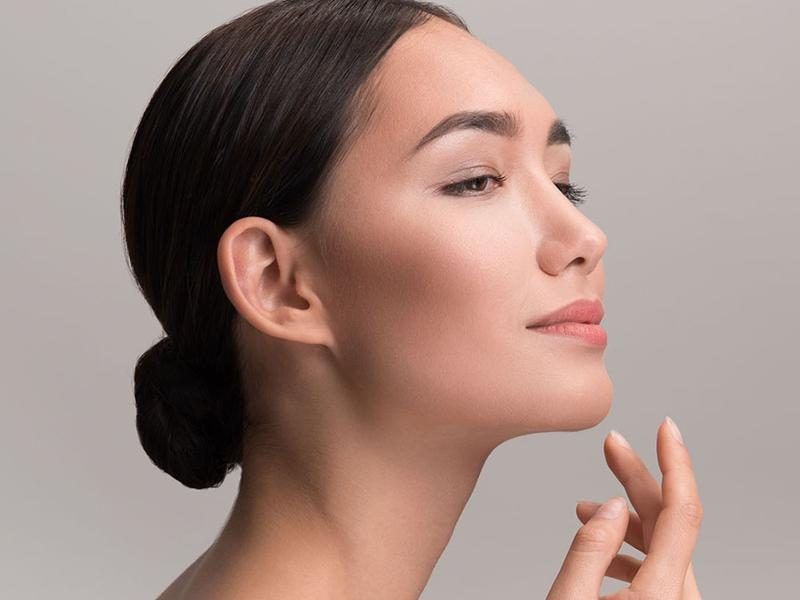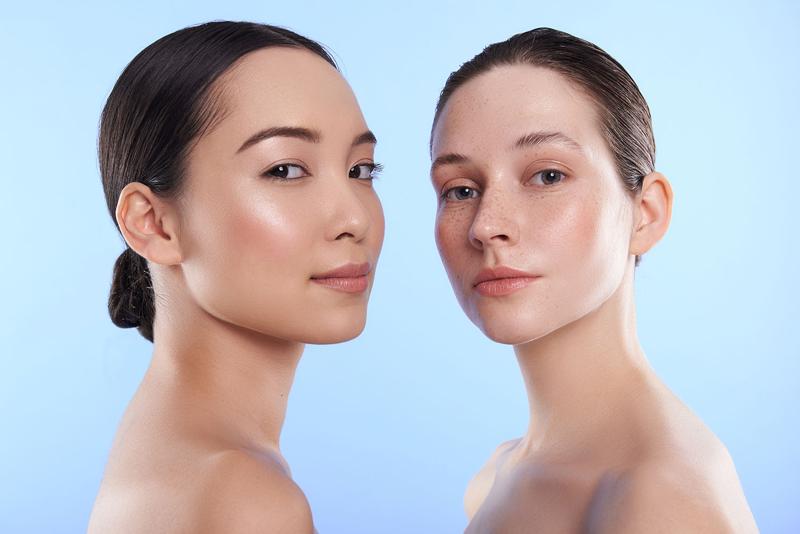Asian Rhinoplasty
Consultations offered at our four convenient locations in La Jolla, San Diego, Newport Beach and Beverly Hills

Asian rhinoplasty is a cosmetic procedure that uses a specific approach to a “nose job,” aiming to preserve ethnically Asian nasal qualities. After decades of “westernization” in the practice of plastic surgery, surgeons now take into consideration a patient’s desire to preserve their ethnic identity. Asian rhinoplasty improves the contour and shape of the nose without erasing a patient’s ethnic anatomy.
At La Jolla Plastic Surgery & Dermatology, we focus on aesthetically pleasing nose augmentation practices. Dr. Richard Chaffoo and Dr. Susan Stuart work together to help their patients look and feel their best. Dr. Chaffoo is one of America’s few triple Board-Certified Plastic Surgeons with decades of experience, including in ethnic rhinoplasty. If you are considering rhinoplasty, schedule a consultation with Dr. Chaffo today. With four conveniently located offices in La Jolla, San Diego, Newport Beach, and Beverly Hills, CA, call us at (800) 373-4773.
Contents
What is Ethnic Rhinoplasty?
Ethnic rhinoplasty is cosmetic nasal surgery that aims to improve the aesthetic features of a patient’s nose without impacting or altering their ethnic characteristics. All ethnicities have distinguishable attributes that individualize each patient, and ethnic rhinoplasty places that truth at the forefront. Typically, aesthetic standards in plastic surgery can be categorized into either Eastern or Western idealistic features.
For Westernized rhinoplasty, patients typically request a nose that is smaller, skinnier, and less droopy. Considering the ideal nose in Eastern cultures differs considerably from the Western ideal, Asian rhinoplasty procedures often aim to make a patient’s nose bigger, longer, and less upturned. Though the procedure techniques and order of operations differ, the anticipated nasal profile is the same for both Eastern and Western rhinoplasty. After surgery, the desired nose shape for both types is very similar, meaning the difference in procedural approach is due to the original nasal shape and ethnic features. (1)
Asian Rhinoplasty
In patients of Asian descent, noses often have the following characteristics: (2)
- Bulbous (rounded) nasal tip
- Thick skin envelope along the tip
- Small septum, leading to upturned tip
- Wide and lowered dorsum (bridge)
- Retracted columella that makes the nostrils wide and visible in profile view
The main aesthetic goal for most Asian patients seeking ethnic rhinoplasty is an increase in dorsal height and tip projection. Instead of focusing on overall nasal reduction methods used for Western patients, Asian rhinoplasty is performed to define and elongate the nasal tip and bridge. This allows Dr. Chaffoo to create the patient’s desired nasal contour without impacting or Westernizing their features. (2)
Asian rhinoplasty often requires the use of cartilage grafts taken from areas of the body like the ear, septum, or ribs. To build up the nasal bridge and achieve appropriate projection, cartilage grafts play a vital role in achieving an optimal result. Dr. Chaffoo can harvest this cartilage and shape it to fit your needs during your rhinoplasty.
For some Asian rhinoplasty patients, reducing or changing the tilt of the nostrils is another step toward their ideal nose. A retracted columella tends to make the nostrils look “flared” or protruded in a distracting way. To remedy this, Dr. Chaffoo can perform alar base surgery using small incisions near the bottom crease of each nostril. He then repositions the nostrils and/or removes tiny amounts of tissue to adjust their angle. (3)
Benefits of Asian Rhinoplasty
- Reinforces the bridge
- Adds projection and lengthen the nose
- Restructures the nose with natural, autologous tissue
- Improves overall facial harmony
- Conserves your ethnic identity and heritage
Dr. Chaffoo is extensively trained in the complex surgical techniques required to perform Asian rhinoplasty. This procedure allows for you to receive your dream nasal contour without interrupting or completely changing your ethnic qualities. The focus on common Asian features guides the procedure, and Dr. Chaffoo takes all of your specific facial qualities into consideration to achieve optimal results.
Read more about rhinoplasty and other cosmetic procedures provided by Dr. Chaffoo on his blog.
Ideal Candidates
The ideal candidate for Asian rhinoplasty is someone of Asian descent or who has common anatomical traits that can be augmented with the surgical techniques used for this procedure. They are in good overall health and a non-smoker. Rhinoplasty is a complicated procedure that presents many challenges, so you must have reasonable expectations about your desired results.
Personal Consultation
Your private consultation with Dr. Chaffoo will allow plenty of time to ask questions and voice your concerns about your rhinoplasty. He will inquire about your medical history, any previous surgeries, and your aesthetic goals. Dr. Chaffoo will create a procedure plan that is tailored to your situation, taking into account your cosmetic desires.
Arrive at this appointment with a detailed description of your ideal nasal contour. Dr. Chaffoo will perform a physical examination of the treatment area to determine your candidacy, and you will be able to see results from prior Asian rhinoplasties performed by Dr. Chaffoo. This is an important step in the procedure process that allows adequate time for both parties to get to know one another to ensure a smooth and successful procedure.
Preparation
To best prepare for Asian rhinoplasty, refrain from smoking tobacco and nicotine products before and after your surgery date. Consumption of these products negatively impacts the body’s ability to heal quickly. Avoid taking NSAIDs like aspirin and ibuprofen to reduce your risk of excess bleeding. If necessary, you can take Tylenol for pain management. It is imperative that you follow Dr. Chaffoo’s preoperative directions closely to ensure the best results.
Fill any prescriptions you will need for your recovery before your surgery date and stop certain medications when instructed. Refrain from alcohol consumption and drink plenty of water to stay hydrated leading up to your appointment date. Arrange for at least a week off of work to recover, and find a trusted loved one who can drive you to and from your procedure.
Asian Rhinoplasty Procedure

Dr. Chaffoo starts the procedure after the administering of general anesthesia, and a local numbing agent to the nose to avoid discomfort. Asian rhinoplasty typically requires an open approach to maximize visualization and access to the nasal dorsum. Once the nasal flap is separated from the internal anatomy of the nose, Dr. Chaffoo works to reduce the fatty tissue surrounding the tip.
During Asian rhinoplasty, the process usually starts with addressing the tip instead of the dorsum like most Western rhinoplasties. The tip projection can be built up with cartilage grafts taken from the septum or ear depending on the patient and their cosmetic needs. After prepping and suturing the grafts in place, Dr. Chaffoo moves on to address the dorsum. This projection can also be extended using grafts.
Only after the dorsum and tip are addressed does Dr. Chaffoo move on to the nostrils. Performing alar base surgery is typically the final step in Asian rhinoplasty. He carefully sutures the incisions, then places splints and a cast to support your new nasal contour while it heals. The procedure takes around 2 hours to complete.
Recovery & Results
The healing process after rhinoplasty can be lengthy. For the first week, it is normal to experience a certain degree of swelling and bruising around your eyes. Ice packs will help to keep this under control. Though you may feel like you have to at times, you must not blow your nose for at least 2 weeks following rhinoplasty. The forced pressure could negatively impact your results. Avoid heavy lifting and strenuous activity for 7 to 10 days. After 2 weeks, your swelling should dissipate considerably. Dr. Chaffoo will remove your splint during your first follow-up appointment.
Final results after rhinoplasty are not commonly visible until the 1-year postoperative mark. You will notice subtle changes over time as your nose shape settles into its intended position, and your final nasal contour is considered permanent.
How Much Does Asian Rhinoplasty Cost in San Diego?
Your total price breakdown is determined by the specific circumstances of your procedure. Certain patients require more comprehensive augmentation and longer surgeries to achieve the desired result, which can affect the final cost. Dr. Chaffoo takes the time during your private consultation to explain the procedure and give a detailed cost estimate.
To schedule an appointment to discuss Asian rhinoplasty at La JollaPlastic Surgery & Dermatology, contact us directly at (800) 373-4773. You can also schedule a consultation at one of our locations in La Jolla, San Diego, Newport Beach, and Beverly Hills, CA by filling out our contact form.
FAQ
What is ethnic rhinoplasty?
Ethnic rhinoplasty techniques take into account the unique anatomical features of non-Caucasian noses to create harmonious results that preserve ethnic identity while addressing specific concerns.
Can I undergo Asian rhinoplasty if I have already had rhinoplasty surgery?
In cases where patients are unhappy with the results of a previous rhinoplasty, revision Asian rhinoplasty can help correct any aesthetic or functional issues.
Will there be scars after an Asian rhinoplasty?
Surgeons minimize and strategically conceal scarring to ensure discreet and aesthetically pleasing results. As residual swelling subsides, you will gradually witness the evolution of your nose’s final outcome, showcasing refined contours and improved nasal harmony.
What is a good starting point for an Asian rhinoplasty patient?
Viewing before and after photos of previous patients can give you a realistic expectation of the potential results of Asian rhinoplasty. Your surgeon will walk you through these images during your consultation to help you visualize the transformation.
References
- Lao WWK, Hsieh TY, Ramirez AE. Differences and Similarities Between Eastern and Western Rhinoplasty. Annals of Plastic Surgery. 2020;86(3S):S259-S264. doi:https://doi.org/10.1097/sap.0000000000002617
- Fakhro A, Wagner RD, Kim YK, Nguyen AH. Milestones of Asian Rhinoplasty. Seminars in Plastic Surgery. 2015;29(4):213-218. doi:https://doi.org/10.1055/s-0035-1564821
- Ishii CH. Current Update in Asian Rhinoplasty. Plastic and Reconstructive Surgery Global Open. 2014;2(4):e133. doi:https://doi.org/10.1097/gox.0000000000000081




